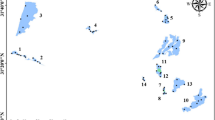Abstract
We used invertebrate bioassessment, habitat analysis, geographic information system analysis of land use, and water chemistry monitoring to evaluate tributaries of a degraded northeast Nebraska, USA, reservoir. Bimonthly invertebrate collections and monthly water chemistry samples were collected for two years on six stream reaches to identify sources contributing to reservoir degradation and test suitability of standard rapid bioassessment methods in this region. A composite biotic index composed of seven commonly used metrics was effective for distinguishing between differentially impacted sites and responded to a variety of disturbances. Individual metrics varied greatly in precision and ability to discriminate between relatively impacted and unimpacted stream reaches. A modified Hilsenhoff index showed the highest precision (reference site CV = 0.08) but was least effective at discriminating among sites. Percent dominance and the EPT (number of Ephemeroptera, Plecoptera, and Trichoptera taxa) metrics were most effective at discriminating between sites and exhibited intermediate precision. A trend of higher biotic integrity during summer was evident, indicating seasonal corrections should differ from other regions. Poor correlations were evident between water chemistry variables and bioassessment results. However, land-use factors, particularly within 18-m riparian zones, were correlated with bioassessment scores. For example, there was a strong negative correlation between percentage of rangeland in 18-m riparian zones and percentage of dominance in streams (r 2 = 0.90, P < 0.01). Results demonstrate that standard rapid bioassessment methods, with some modifications, are effective for use in this agricultural region of the Great Plains and that riparian land use may be the best predictor of stream biotic integrity.
Similar content being viewed by others
Author information
Authors and Affiliations
Rights and permissions
About this article
Cite this article
Whiles, M., Brock, B., Franzen, A. et al. Stream Invertebrate Communities, Water Quality, and Land-Use Patterns in an Agricultural Drainage Basin of Northeastern Nebraska, USA. Environmental Management 26, 563–576 (2000). https://doi.org/10.1007/s002670010113
Published:
Issue Date:
DOI: https://doi.org/10.1007/s002670010113




